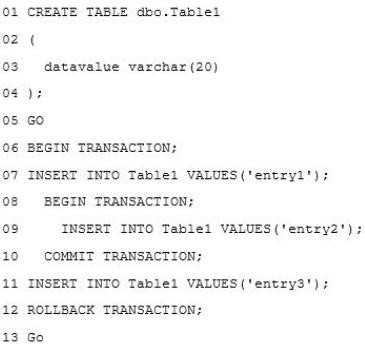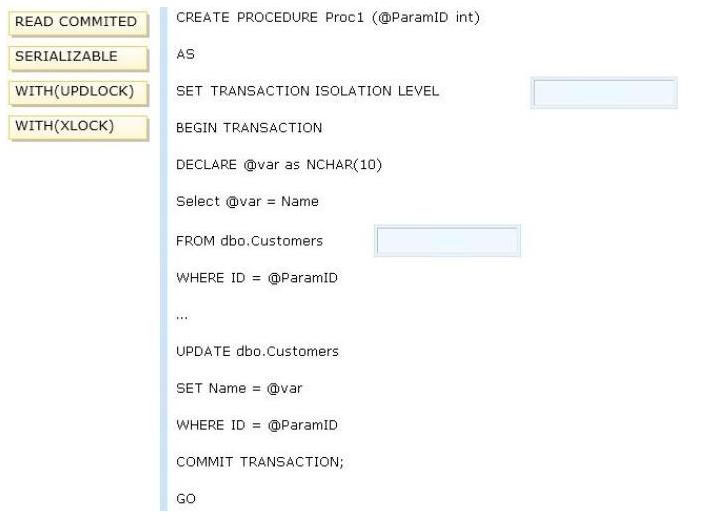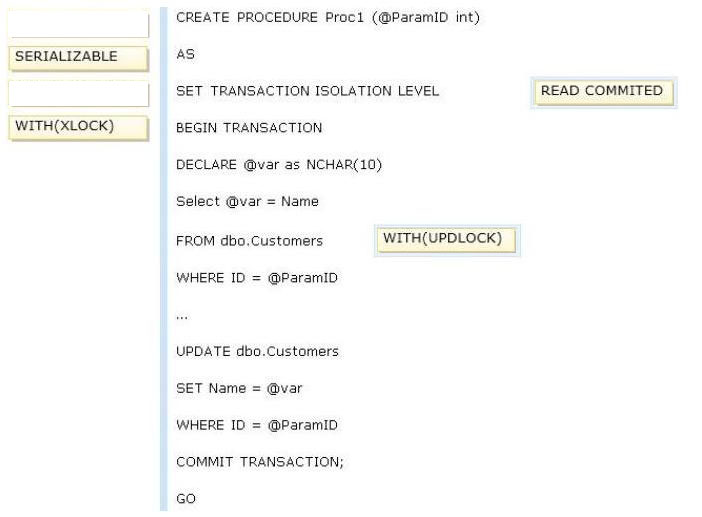Microsoft 70-464 Exam Practice Questions (P. 5)
- Full Access (209 questions)
- Six months of Premium Access
- Access to one million comments
- Seamless ChatGPT Integration
- Ability to download PDF files
- Anki Flashcard files for revision
- No Captcha & No AdSense
- Advanced Exam Configuration
Question #21
You need to identify which long running transactions use an index.
Which dynamic management view should you use?
Which dynamic management view should you use?
- Asys.dm_exec_query_optimizer_info
- Bsys.dm_exec_plan_attributes
- Csys.dm_exec_requests
- Dsys.dm_exec_procedure_stats
Correct Answer:
A
sys.dm_exec_query_optimizer_info teturns detailed statistics about the operation of the SQL Server query optimizer. You can use this view when tuning a workload to identify query optimization problems or improvements. For example, you can use the total number of optimizations, the elapsed time value, and the final cost value to compare the query optimizations of the current workload and any changes observed during the tuning process.
References:
https://docs.microsoft.com/en-us/sql/relational-databases/system-dynamic-management-views/sys-dm-exec-query-optimizer-info-transact-sql
A
sys.dm_exec_query_optimizer_info teturns detailed statistics about the operation of the SQL Server query optimizer. You can use this view when tuning a workload to identify query optimization problems or improvements. For example, you can use the total number of optimizations, the elapsed time value, and the final cost value to compare the query optimizations of the current workload and any changes observed during the tuning process.
References:
https://docs.microsoft.com/en-us/sql/relational-databases/system-dynamic-management-views/sys-dm-exec-query-optimizer-info-transact-sql
send
light_mode
delete
Question #22
You create a table named Customers by using the following code segment:

You create a non-clustered index named IX_Name on the name column.
You write the following query to retrieve all of the customers that have a name that starts with the letters SMI:

You discover that the query performs a table scan.
You need to ensure that the query uses the index.
What should you do?

You create a non-clustered index named IX_Name on the name column.
You write the following query to retrieve all of the customers that have a name that starts with the letters SMI:

You discover that the query performs a table scan.
You need to ensure that the query uses the index.
What should you do?
- AReplace LEFT(name,3) = 'smi' by using name like 'smi%'
- BReplace LEFT(name,3) = 'smi' by using substring(name,l,3) = 'smi'
- CRecreate IX_Name as a unique index
- DRecreate IX Name as a clustered index
Correct Answer:
A
A
send
light_mode
delete
Question #23
You plan to execute the following code:

You need to identify how many rows will be in dbo.Table1 after you execute the code.
How many rows should you identify?

You need to identify how many rows will be in dbo.Table1 after you execute the code.
How many rows should you identify?
send
light_mode
delete
Question #24
You plan to design an application that temporarily stores data in a SQL Azure database.
You need to identify which types of database objects can be used to store data for the application. The solution must ensure that the application can make changes to the schema of a temporary object during a session.
Which type of objects should you identify?
You need to identify which types of database objects can be used to store data for the application. The solution must ensure that the application can make changes to the schema of a temporary object during a session.
Which type of objects should you identify?
- ACommon table expressions (CTEs)
- BTemporary stored procedures
- CTemporary tables
- DTable variables
Correct Answer:
C
http://msdn.microsoft.com/en-us/library/ms175972.aspx
http://msdn.microsoft.com/en-us/library/ms189084.aspx
http://msdn.microsoft.com/en-us/library/ms175010.aspx
http://msdn.microsoft.com/en-us/library/bb510489.aspx
http://msdn.microsoft.com/en-us/library/ms187926.aspx
http://zacksfiasco.com/post/2010/01/21/SQL-Server-Temporary-Stored-Procedures.aspx
C
http://msdn.microsoft.com/en-us/library/ms175972.aspx
http://msdn.microsoft.com/en-us/library/ms189084.aspx
http://msdn.microsoft.com/en-us/library/ms175010.aspx
http://msdn.microsoft.com/en-us/library/bb510489.aspx
http://msdn.microsoft.com/en-us/library/ms187926.aspx
http://zacksfiasco.com/post/2010/01/21/SQL-Server-Temporary-Stored-Procedures.aspx
send
light_mode
delete
Question #25
DRAG DROP -
You have a table named Customers that has a clustered index defined on the ID column.
You write a script to create a stored procedure.
You need to complete the script for the stored procedure. The solution must minimize the number of locks and deadlocks.
What should you do?
To answer, drag the appropriate option to the correct location in the answer area. (Answer choices may be used once, more than once, or not at all.)
Select and Place:

You have a table named Customers that has a clustered index defined on the ID column.
You write a script to create a stored procedure.
You need to complete the script for the stored procedure. The solution must minimize the number of locks and deadlocks.
What should you do?
To answer, drag the appropriate option to the correct location in the answer area. (Answer choices may be used once, more than once, or not at all.)
Select and Place:

Correct Answer:

Note:
* Optimized bulk load operations on heaps block queries that are running under the following isolation levels:
✑ SNAPSHOT
✑ READ UNCOMMITTED
✑ READ COMMITTED using row versioning
* READ COMMITTED
Specifies that statements cannot read data that has been modified but not committed by other transactions. This prevents dirty reads. Data can be changed by other transactions between individual statements within the current transaction, resulting in nonrepeatable reads or phantom data. This option is the SQL Server default.
* SERIALIZABLE (more locks)
Specifies the following:
Statements cannot read data that has been modified but not yet committed by other transactions. No other transactions can modify data that has been read by the current transaction until the current transaction completes.
Other transactions cannot insert new rows with key values that would fall in the range of keys read by any statements in the current transaction until the current transaction completes.
* UPDLOCK
Specifies that update locks are to be taken and held until the transaction completes. UPDLOCK takes update locks for read operations only at the row-level or page-level. If UPDLOCK is combined with TABLOCK, or a table-level lock is taken for some other reason, an exclusive (X) lock will be taken instead.
When UPDLOCK is specified, the READCOMMITTED and READCOMMITTEDLOCK isolation level hints are ignored. For example, if the isolation level of the session is set to SERIALIZABLE and a query specifies (UPDLOCK, READCOMMITTED), the READCOMMITTED hint is ignored and the transaction is run using the SERIALIZABLE isolation level.
* XLOCK
Specifies that exclusive locks are to be taken and held until the transaction completes. If specified with ROWLOCK, PAGLOCK, or TABLOCK, the exclusive locks apply to the appropriate level of granularity.

Note:
* Optimized bulk load operations on heaps block queries that are running under the following isolation levels:
✑ SNAPSHOT
✑ READ UNCOMMITTED
✑ READ COMMITTED using row versioning
* READ COMMITTED
Specifies that statements cannot read data that has been modified but not committed by other transactions. This prevents dirty reads. Data can be changed by other transactions between individual statements within the current transaction, resulting in nonrepeatable reads or phantom data. This option is the SQL Server default.
* SERIALIZABLE (more locks)
Specifies the following:
Statements cannot read data that has been modified but not yet committed by other transactions. No other transactions can modify data that has been read by the current transaction until the current transaction completes.
Other transactions cannot insert new rows with key values that would fall in the range of keys read by any statements in the current transaction until the current transaction completes.
* UPDLOCK
Specifies that update locks are to be taken and held until the transaction completes. UPDLOCK takes update locks for read operations only at the row-level or page-level. If UPDLOCK is combined with TABLOCK, or a table-level lock is taken for some other reason, an exclusive (X) lock will be taken instead.
When UPDLOCK is specified, the READCOMMITTED and READCOMMITTEDLOCK isolation level hints are ignored. For example, if the isolation level of the session is set to SERIALIZABLE and a query specifies (UPDLOCK, READCOMMITTED), the READCOMMITTED hint is ignored and the transaction is run using the SERIALIZABLE isolation level.
* XLOCK
Specifies that exclusive locks are to be taken and held until the transaction completes. If specified with ROWLOCK, PAGLOCK, or TABLOCK, the exclusive locks apply to the appropriate level of granularity.
send
light_mode
delete
All Pages
